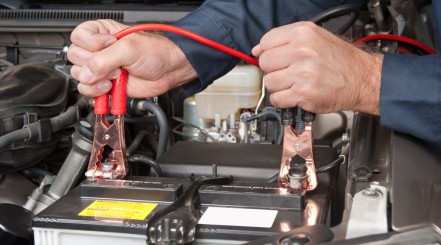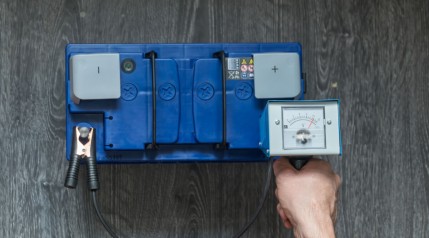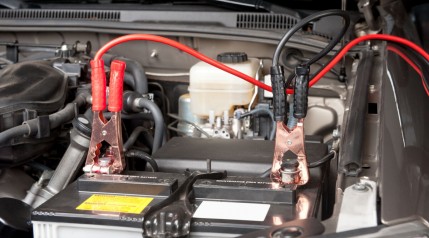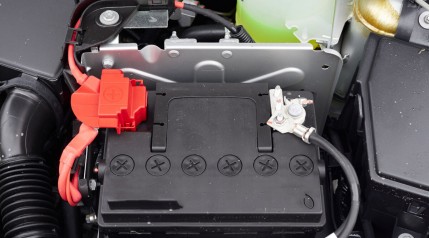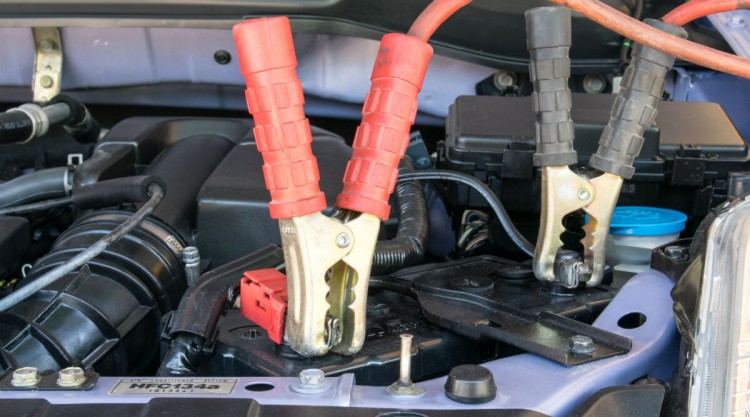
If you own a car, there’s a good chance you’ve experienced the frustration of a flat battery. This is such a common occurrence that we always recommend keeping a car battery charger in your trunk at all times, so you can either top up your battery or jumpstart your vehicle when needed and avoid being stranded.
Once you’ve equipped yourself with a good car battery charger, all that remains is to learn how to use the thing when the time comes. And that’s where we come in!
In this post, we’ll show you how to use a car battery charger with a series of simple steps, as well as reveal all the safety precautions you should take to ensure you get the job without a hitch.
Skill level: Beginner.
Time to Complete: 2–24 hours depending on the charge speed.
Tools needed: Before using your charger, ensure you have the required tools and gear to operate it safely.
- The proper car battery charger with its instructions.
- Insulated cable set with its storage case—if they don’t already come with the charger.
- Thick gloves and eye protection.
Contents (Jump to Topic)
Key Takeaways
Safety First – Always wear gloves and safety glasses, clean the terminals, and ensure you have good ventilation before attempting to charge your car battery.
Slow Is the Way to Go – A slow charge rate is better for your battery’s health and will be more efficient in the long run.
Charge Times – A trickle charge might take as long as 24 hours, while a fast charge can take as little as 2 hours
How to Use a Car Battery Charger
Following is a step-by-step guide that should work with almost all chargers, as the instructions for their use are pretty much always the same.
Getting Your Battery Ready
Depending on the model of your car, batteries can be found in different places in your engine.
You’ll almost always find them under the hood, but sometimes they can also be located below the side of a car or even under the back seat.
Removing Your Battery
Car batteries can give life-threatening electric shocks when not handled with proper care.
If you need to remove the car battery to charge it – if you cannot charge it in situ – please adhere to the following steps:
- Make sure to use insulated work gloves and safety glasses.
- Ensure that the engine is turned off.
- Remove the ground/negative terminal/black clamp first.
- Next, proceed with the positive cable and positive terminal.
Know Your Battery’s Specifications
Your owner’s manual should provide you with the battery voltage. Most of the time, it’s even displayed on the device itself. Most batteries are 12 volts, but it’s best to check as some can be 6v or even higher than 12.
If you have a sealed-type device, follow your manufacturer’s specifications closely. Pay specific attention to any warnings.
Ensure You Have Good Ventilation
Although some batteries cannot be moved, it’s best to remove them from the car and select a safe location for the charging process. Some cells can give off noxious gas while charging, particularly if something goes wrong. Some batteries can even generate hydrogen gas while charging. A lack of ventilation could lead to an explosion.
So, please ensure good ventilation around the device while charging. A wide-open area with a draft would be ideal. Flammable substances—such as lighters or gasoline—should be kept away. A simple static electricity spark could have disastrous consequences.
Cleaning the Terminals
Before starting charging, check the terminals and ensure that they’re clean. If you notice a white powdery substance on the terminals, they need cleaning.
At this point, you should be wearing gloves. Sulfuric acid can cause burns when handled with bare hands.
Take a scratchpad, sandpaper, or terminal cleaning brush to clean the terminals, then wipe the area down with a wet cloth with baking soda. Make sure to get none of the liquid on either your skin or your clothes.
Remove the Cell Caps
Some batteries come with cell caps. When not removed, the caps prevent gasses from escaping, so these must be removed before starting your battery charge.
The caps are often located underneath a removable yellow strip, on top of the device.
Water Refill
A battery without water might not be able to hold the charge, and those that have suffered a prolonged period without enough water may have suffered permanent damage.
Batteries can, however, be refilled with distilled water and brought back to life with a charge. It doesn’t always work. The success of the procedure will vary depending on how long it has been dry and the quality of the car battery. How old the device is will also come into play.
Unfortunately, you’ll only find out once you start charging it.
Hooking Up the Battery Charger
Now that we have both the battery and the charger ready, let’s get them connected.
Disconnect All Power
Turn off the engine as well as every device that could use up energy. These include headlights, internal lights, or stereo systems.
Disconnect the Charger
Ensure that the charger power button is turned off. It also shouldn’t be plugged into an outlet.
Remove Cables from Battery Terminals
Both cables should be removed from the battery, completely disconnecting it from the car.
Start with the black cable (negative charge) before taking off the red cable (positive charge).
Attach the Charger Cables
Chargers come with two wires or cables, one to attach to each of the terminals.
The red wire should be connected to the battery’s red terminal—often labeled POS or A+. Then connect the black wire (the negative cable) to the other (negative) terminal, the black one labeled NEG.
Make sure that the two wires never come into contact. This could create serious burns and even cause an explosion and is the reason why we unplug the charger before connecting it!
Setting up the Charge Rate
Set the voltage and amperage needed for the charge. You mainly have two options available.
A slow charge is preferable. It’s also called the trickle charging method. It’s safer for your car, and for you. The charge will also be more efficient as it holds current for a more extended period of time.
If you’re in a rush, choose a higher amperage for a quicker charge time. A faster charge can take as little as two hours. However, it does pose greater danger for your vehicle’s battery, and can shorten its lifespan.
Turn the Charger On
You’re ready. Plug in and turn the charger on. Don’t forget to set the timer as well.
The gauge should indicate that the device is being charged, and the arrow should slowly be moving back to the green zone. Don’t touch or move the cords during the process.
If the charge was very low and you’re using a slow charge rate, it will take many hours to reach a full charge. Don’t expect to see instant results reflected in the charge meter, come back and check after some time.
How Long Should You Charge a Car Battery for?
This depends on the capacity of your car battery. In most cars, the battery will hold 48 amp-hours of charge. Each hour can recharge about one amp.
A trickle charge—2 amps—might take 24 hours to charge a dead battery back to a reasonable level. This may take up some of your time, but it’s preferable if you’d like to maintain a healthy battery.
40-amp chargers are efficient and will allow you to fully charge your battery much faster. This fast charge speed shouldn’t be used frequently as it might damage the battery plate.
Some chargers will require you to manually monitor the charge, while others will shut off automatically when it’s fully charged.
Don’t think that overcharging is safer than undercharging. It’s the opposite, and an overcharge will damage your car’s battery over time.
Once Fully Charged, Safely Disconnect
Once the charger indicates that the battery is fully charged, disconnect everything.
Doing so with the correct procedure will avoid sparks, burns, and other disagreements. Here are some guidelines.
- Turn the charging device off.
- Unplug the charging device from the electrical outlet.
- Remove the black (negative charge) cable first.
- Then proceed with the red (positive charge) cable.
- Place the charged battery back in the car.
Safety Tips
Besides wearing gloves and glasses, there are a few things to keep in mind to ensure your safety.
Avoid Sparks
A few helpful tips can avoid sparks and more potential harmful consequences.
- Avoid letting wires or clips touch each other.
- Only use insulated wires.
- Have the charger disconnected from the mains at all times unless it’s fully connected to the battery and in use.
- Avoid touching any part of the car engine with any clamps or connections.
Dealing With a Frozen Battery
A frozen battery can be a safety hazard. It prevents gas from escaping during charging and if you try to charge while frozen, the gas can expand until it explodes and releases battery acid.
This is more likely to happen with AGM batteries, as they have a lower pH level and reach their freezing point faster.
Most batteries should withstand cold temperatures down to 50 degrees Fahrenheit. When distilled water and sulfuric acid don’t mix properly, the water can freeze inside the device.
Avoid jumpstarting if it’s frozen. If it shows cracks, it’s best to replace it. If you don’t notice cracks, warm it up before charging. In this case, a maximum charge of 10 amps should be used.
When to Seek Professional Advice
Towards the end of a charge, cells bubble and can emit gas. They can also emit a violent noise. In this case, the entire device might be failing, and you should have it checked by a professional.
Choosing the Right Charger
Not all modern battery chargers fit every battery. Batteries come in a variety of different types, from valve-regulated lead-acid to gel, and absorbed glass mat to lithium batteries. Each requires a particular kind of charger.
Please check out our article on car battery chargers for more information if you’re still looking to buy and need some advice.
Summary
Charging your battery might seem intimidating when taking on the project for the first time. Yet, it isn’t a complicated process. Even the most inexperienced car owners should be able to succeed.
Following the steps above will make the process faster, and it should also make it safer. For yourself and your battery.
Do you have any questions? Please leave us a comment in the section below. We read and answer them all.

